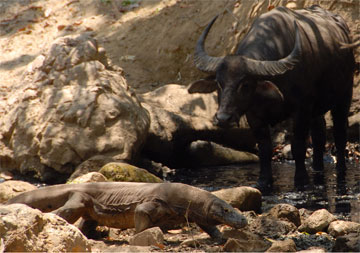A new study has shown the world’s largest lizard to be poisonous
The world’s largest lizard relies on venom to weaken and immobilize its prey, report researchers writing in Proceedings of the National Academy of Sciences. Until now it was believed that bacteria resident in the Komodo Dragon’s mouth were the source of the reptile’s toxicity.
Bryan Fry of the University of Melbourne and colleagues used computer models to show that though the Komodo Dragon possesses a relatively week bite, a combination of serrated teeth and venom make it a powerful hunter capable of bringing down large mammals like deer, goats, wild boar and in rare cases, humans.

|
“These large carnivorous reptiles are known to bite prey and release them, leaving the prey to bleed to death from the horrific wounds inflicted. We have now shown that it is the combined arsenal of the Komodo Dragon’s tooth and venom that account for their hunting prowess,” said Fry. “The combination of this specialized bite and venom seem to minimise the Dragon’s contact with its prey and this allows it to take large animals.”
The dragon’s venom gland was identified using magnetic resonance imaging and subsequently excised from a terminally ill dragon from the Singapore Zoological Gardens. The researchers write that the dragon possesses “the most structurally complex reptile venom gland described to date”, exceeding that of the gila monster, a venomous lizard found in the American Southwest. But like the gila monster, as well as some species of poisonous snake, the dragon’s venom works by causing “a severe loss in blood pressure by preventing blood clotting and widening blood vessels, thus inducing shock in a victim.”
The researchers also examined fossils of the Komodo’s extinct relative, Megalania, a beast that attained a length of seven meters (23 feet) and could weight up to 2,000 kilograms (2.2 tons). They determined that the ancient lizard was one of the largest venomous animals to have ever lived.
Bryan G. Fry et al (2009). A central role for venom in predation by Varanus komodoensis (Komodo Dragon) and the extinct giant Varanus (Megalania) prisca. PNAS Early Edition for the week of May 18, 2009. www.pnas.org/cgi/doi/10.1073/pnas.0810883106








